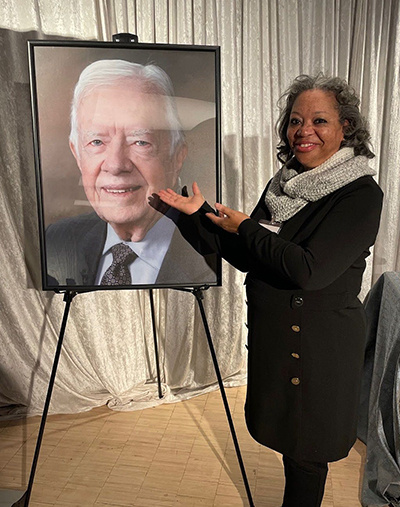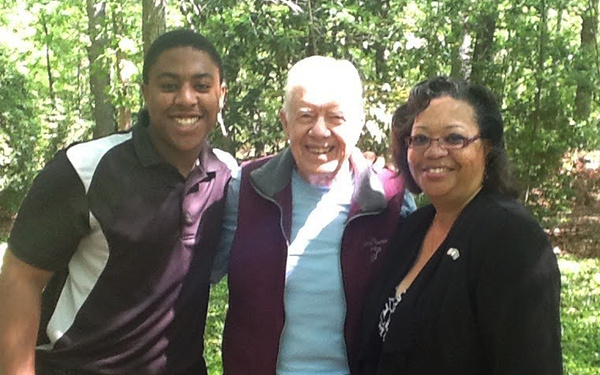
Ambassador Susan D. Page, Professor of Practice in International Diplomacy, offers reflections on President Jimmy Carter, peacemaking in Sudan and South Sudan, and international service. She serves on the Board of Trustees of the Carter Center and was an invited attendee at Carter’s state funeral on January 9, 2025.
Reflections on President Jimmy Carter and January 9th
Written by Susan D. Page
As a trustee of The Carter Center, the nongovernmental, non-profit organization founded in 1982 by former President Jimmy Carter and his wife Rosalynn, I received personal invitations to attend the viewing of President Carter lying in State in both the Georgia State House and the U.S. Capitol Rotunda, as well as the State funeral for the 39th U.S. president held at the Washington National Cathedral on January 9, 2025. It was a special honor to attend his final, reverent farewell on a date of great significance to me and to our mutual link to Sudan and South Sudan.

Long before I was first posted to East, Southern and then Central Africa as a foreign service officer, President Carter and The Carter Center had been engaged for years in peacemaking with Sudanese officials and, with ordinary citizens of the country, in eradication efforts to end the scourge of guinea worm, a neglected tropical disease, but it wasn’t until the I began working on Sudan that I came to understand the significance of the role of President Carter.
From 2002-2005, I served as the legal advisor to the Intergovernmental Authority on Development (IGAD) Secretariat for Peace in the Sudan, seconded by the U.S. Department of State, to assist Kenyan chief mediator, Lt. Gen. Lazaro K. Sumbeiywo, with the peace process. IGAD, a subsidiary organ of the African Union comprising the states of the Horn of Africa, had been charged with mediating an end to the second Sudanese Civil War that erupted in 1983. After two and a half years of tough negotiations, on January 9, 2005, I assisted in the signing ceremony of the historic Comprehensive Peace Agreement (CPA) between the government of the Republic of Sudan and the Sudan People’s Liberation Movement/Army. The CPA contained a now-famous provision that included a referendum for the people of Southern Sudan to vote to remain united with Sudan or to secede after a six-year Interim Period where the signatories would work “to make unity attractive.”
From the signing of the CPA in 2005, President Carter and The Carter Center stepped up their already robust engagement and programming throughout Sudan to consolidate gains in health, peacebuilding, citizen participation, voter education, and democracy and governance throughout the Interim Period. On yet another January 9, President Carter led The Carter Center’s Referendum Observation Mission, witnessing the historic voting that began on January 9, 2011. At the time, I was in Washington serving as a deputy Secretary of State for African Affairs covering Sudan and watching the implementation (and lack thereof) of the peace agreement I had helped to draft.
The Republic of South Sudan became the world’s newest nation on July 9, 2011, and I was sworn in as the first U.S. ambassador to South Sudan several months later. During my tenure as ambassador, I visited The Carter Center’s numerous projects and activities and witnessed The Carter Center’s exceptional personnel working to advance peace between the two separate countries, even as the situation within South Sudan and between the North and South deteriorated.
Even though I had gone to The Carter Center in Atlanta on more than one occasion, and had met numerous heads of state, foreign government officials, and other notable personalities in my career as a diplomat with the U.S. government, the United Nations, and IGAD, I never had any expectation of meeting President Carter in person.
However, during a visit to The Carter Center while on a short break from South Sudan, I was informed that senior Carter Center officials had secured a meeting for me with the former president, who remained actively engaged in peace efforts in Sudan and South Sudan. On April 23, 2013, along with my then-teenaged son, I met President Jimmy Carter at his home in Plains, Georgia. I marveled at his down-to-earth, Southern welcome: there was no housekeeper to lead us into a waiting sitting room. Instead, President Carter himself opened the door and greeted us as if we were old friends. Wearing faded blue jeans, a nondescript long-sleeved T-shirt, and a light vest with “The Carter Center” logo emblazoned upon it, he welcomed us into his home, explaining that “Rosalynn was out visiting a sick friend.” After inquiring about my son’s interests, President Carter spoke admiringly about his mother, Lillian, who, in 1966, at age 68, announced to her grown children that she would be leaving soon for India as a Peace Corps Volunteer (!!) and told us about his grandson, Jason, whose Peace Corps service had been in South Africa. As a U-M alumna, I was well-aware that President Kennedy had first pitched his international public service idea on the steps of the Michigan Union and told President Carter about our “mutual” U-M connection.

After autographing several books, we began discussing Sudan and South Sudan in detail. During that long-ago visit to Plains, Georgia, President Carter offered me his personal insights from his long engagement in the region and with various personalities from which I took inspiration, especially during the more difficult days of my tenure as ambassador to the newly independent South Sudan. A few years later, President Carter spoke at a conference of mediators in Oslo, Norway, that I attended. To my complete surprise, he recognized me and called on me by name in front of the audience! I learned only recently that President Carter had nearly perfect recall of names and faces, places, and dates.
President Carter’s final farewell ceremony at Washington National Cathedral could not have been timed more perfectly for the remarkable roles he played in the history of Sudan and South Sudan. January 9, 2025, marked twenty years to the day of the signing of the Comprehensive Peace Agreement for Sudan and exactly fourteen years from January 9, 2011, when President Carter observed the Southern Sudanese Referendum. And just as I can never forget these dates that I helped the parties to include in the peace agreement, I will always remember that on January 9, 2025, President Jimmy Carter was laid to rest in Plains, Georgia, where he began his life, a life of faith, dedicated service, love for family and neighbor near and far, and his commitment to “waging peace.”
More news from the Ford School
